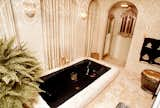Welcome to Origin Story, a series that chronicles the lesser-known histories of designs that have shaped how we live.
During its short life span, carpet has really been through the wringer. Once a status symbol—wall-to-wall carpet was considered a luxury for most American families before the mid-1900s—by the end of the 20th century it was out of date, cast aside by many American consumers in favor of easier-to-clean surfaces. While hardwood has been the gold standard of home flooring for much of the 21st century, we haven’t seen the last of fabric-covered floors. It’s something old, which means it’s bound to become new again. Here are some of the myriad ways carpet has captivated us throughout the decades.
1950s
Wall-to-Wall
As millions of families moved into new-construction houses during the post-WWII building boom, they were ready to splurge on decor. Recent advances in production technology made it possible for tufted nylon to replace woven wool as the dominant carpet type, and it quickly became the fashion to stretch carpet from one wall to another. The Saxony style consisted of tightly twisted cut-pile fibers that stood straight up, creating a dense, soft feel and a uniform look. Bright blues, rich burgundies, and emerald greens were all common color options for the average suburbanite.
Shag carpeting dominated American households in the 1960s and ’70s.
1960s and ’70s
Shagadelic, Baby
Not unlike the era’s shifting ethos, machine-made carpet began to get higher and looser in the ’60s: We’re talking, of course, about shag. Made possible by advancements in technology that allowed for brighter colors and looser weaves, shag also came to symbolize newness—a big deal in a decade defined by its emphasis on looking forward. Its appeal might have been that the textured fibers are fun to roll around in, plush enough to encourage partygoers to move from the couch to the floor. (A home-design stand-in for the Swinging Sixties if ever there was one.) By the ’70s, shag was still the ultimate in carpet style, and the palettes were multicolor, appearing in burnt orange, avocado green, and more.

Carpeted bathrooms with sunken tubs gained popularity in the 1980s.
1980s
More Carpet Everywhere
By the 1980s, homeowners became savvier about maintenance. Enter Berber carpeting, a relatively inexpensive, looped style beloved for its durability and resistance to footprints. This emphasis on wear resistance translated to an uptick in carpet in new places. “Why not?” the approach from interior designers seemed to say. Don’t like stepping on cold tile as you climb out of the tub? Let’s cover the bathroom floor in plush, peach-colored carpet. What could go wrong? As decor color palettes shifted from the earthy shades of the ’70s to a mix of preppy pinks and ’80s-do-’30s pastels, those colors found their way onto carpeted floors in homes across the country.

Flooring trends shifted away from carpeting in the 1900s and early 2000s, with many American homeowners opting instead for hardwood surfaces.
1990s and 2000s
The Hardwood Revolution
TV has long influenced how Americans decorate their homes, and by the end of the 20th century, some of the era’s most popular programs fell solidly into late-night rerun territory, making the shag-covered world of The Brady Bunch seem decidedly old-fashioned. HGTV, a network practically built on the idea of ripping out old carpet and replacing it with new hardwood, launched in 1994, inspiring millions of Americans to projectify their homes. If the ’50s were about showing your neighbors you could afford a house full of carpet, the turn of the century was about opting instead for hardwood floors, gleaming and bare beneath the Pottery Barn and Restoration Hardware pieces that symbolized casual, yuppieish elegance to people who associated carpet with the basement at Mom and Dad’s house.

Gucci’s Fall/Winter 2023 fashion show featured wall-to-wall carpeting in avocado green.








